Analysis of China's Lewisian Turning Point and Global Economic Effects
VerifiedAdded on 2020/04/07
|12
|2821
|33
Essay
AI Summary
This essay critically examines the claim that China's economy has reached its Lewisian Turning Point earlier than expected, and the potential consequences. The essay explains the Lewisian Turning Point model, which predicts a shift from surplus to shortage in the labor market as economic growth occurs. It analyzes the impact on China, including rising wages, shifts in labor supply, inflationary pressures, and a potential decline in the potential growth rate. The essay further discusses the impact on the global economy, including changes in international trade, comparative prices, and the shift in China's economic development trend towards higher productivity. The paper uses data and analysis to support its arguments, including the impacts on wages, regional gaps, and the government's economic policies. The essay concludes by discussing the shift in China's focus from job creation to productivity enhancement and its implications for both China and the global economy.
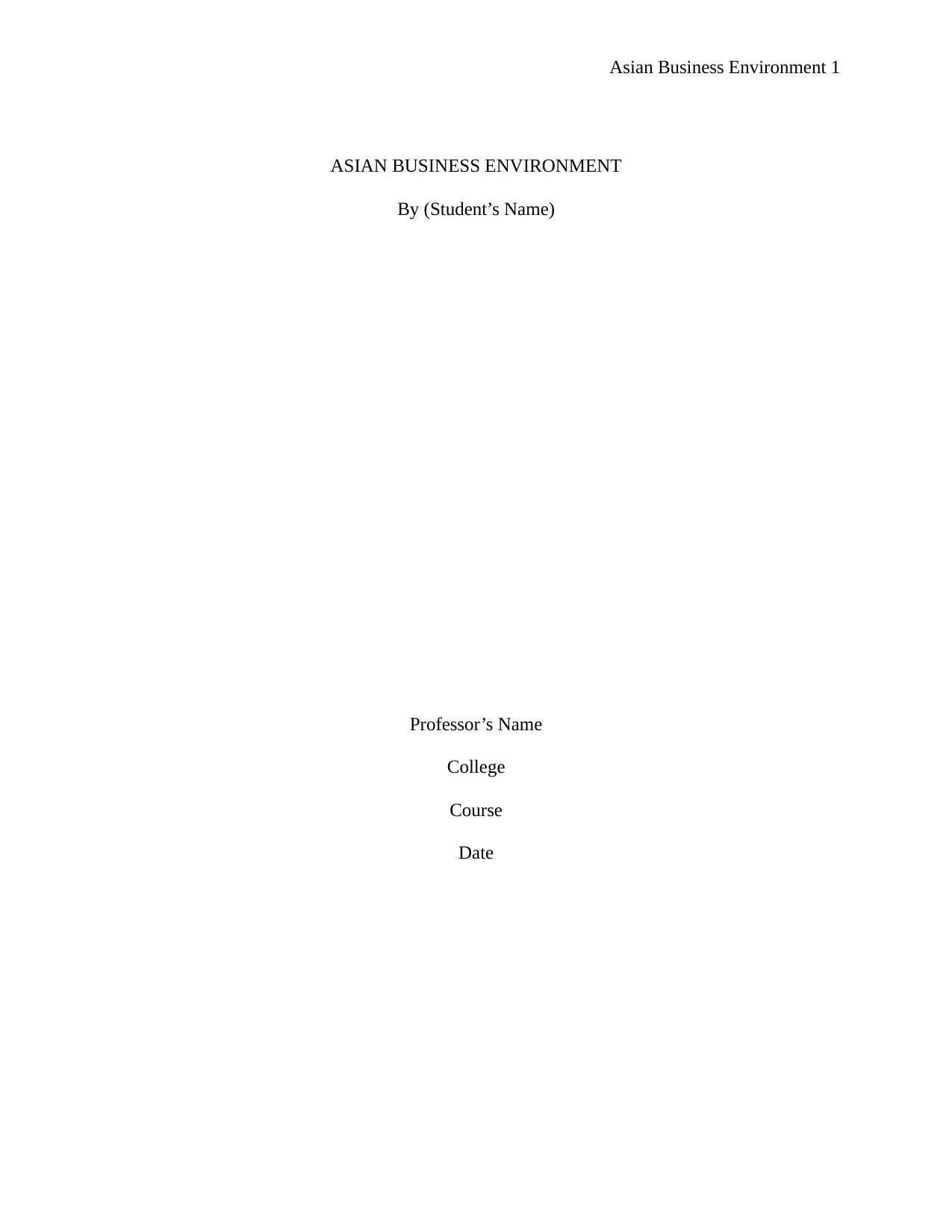
Asian Business Environment 1
ASIAN BUSINESS ENVIRONMENT
By (Student’s Name)
Professor’s Name
College
Course
Date
ASIAN BUSINESS ENVIRONMENT
By (Student’s Name)
Professor’s Name
College
Course
Date
Paraphrase This Document
Need a fresh take? Get an instant paraphrase of this document with our AI Paraphraser
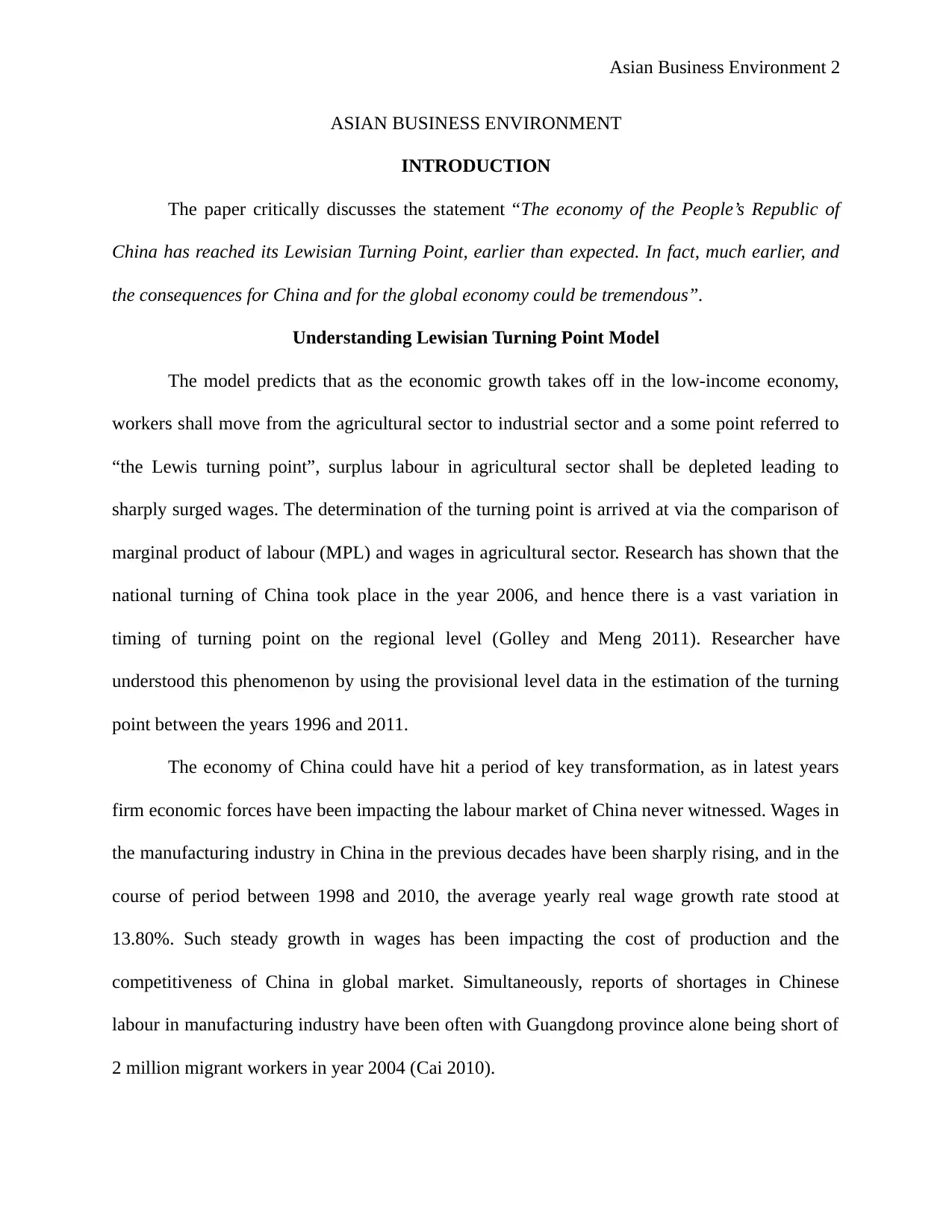
Asian Business Environment 2
ASIAN BUSINESS ENVIRONMENT
INTRODUCTION
The paper critically discusses the statement “The economy of the People’s Republic of
China has reached its Lewisian Turning Point, earlier than expected. In fact, much earlier, and
the consequences for China and for the global economy could be tremendous”.
Understanding Lewisian Turning Point Model
The model predicts that as the economic growth takes off in the low-income economy,
workers shall move from the agricultural sector to industrial sector and a some point referred to
“the Lewis turning point”, surplus labour in agricultural sector shall be depleted leading to
sharply surged wages. The determination of the turning point is arrived at via the comparison of
marginal product of labour (MPL) and wages in agricultural sector. Research has shown that the
national turning of China took place in the year 2006, and hence there is a vast variation in
timing of turning point on the regional level (Golley and Meng 2011). Researcher have
understood this phenomenon by using the provisional level data in the estimation of the turning
point between the years 1996 and 2011.
The economy of China could have hit a period of key transformation, as in latest years
firm economic forces have been impacting the labour market of China never witnessed. Wages in
the manufacturing industry in China in the previous decades have been sharply rising, and in the
course of period between 1998 and 2010, the average yearly real wage growth rate stood at
13.80%. Such steady growth in wages has been impacting the cost of production and the
competitiveness of China in global market. Simultaneously, reports of shortages in Chinese
labour in manufacturing industry have been often with Guangdong province alone being short of
2 million migrant workers in year 2004 (Cai 2010).
ASIAN BUSINESS ENVIRONMENT
INTRODUCTION
The paper critically discusses the statement “The economy of the People’s Republic of
China has reached its Lewisian Turning Point, earlier than expected. In fact, much earlier, and
the consequences for China and for the global economy could be tremendous”.
Understanding Lewisian Turning Point Model
The model predicts that as the economic growth takes off in the low-income economy,
workers shall move from the agricultural sector to industrial sector and a some point referred to
“the Lewis turning point”, surplus labour in agricultural sector shall be depleted leading to
sharply surged wages. The determination of the turning point is arrived at via the comparison of
marginal product of labour (MPL) and wages in agricultural sector. Research has shown that the
national turning of China took place in the year 2006, and hence there is a vast variation in
timing of turning point on the regional level (Golley and Meng 2011). Researcher have
understood this phenomenon by using the provisional level data in the estimation of the turning
point between the years 1996 and 2011.
The economy of China could have hit a period of key transformation, as in latest years
firm economic forces have been impacting the labour market of China never witnessed. Wages in
the manufacturing industry in China in the previous decades have been sharply rising, and in the
course of period between 1998 and 2010, the average yearly real wage growth rate stood at
13.80%. Such steady growth in wages has been impacting the cost of production and the
competitiveness of China in global market. Simultaneously, reports of shortages in Chinese
labour in manufacturing industry have been often with Guangdong province alone being short of
2 million migrant workers in year 2004 (Cai 2010).
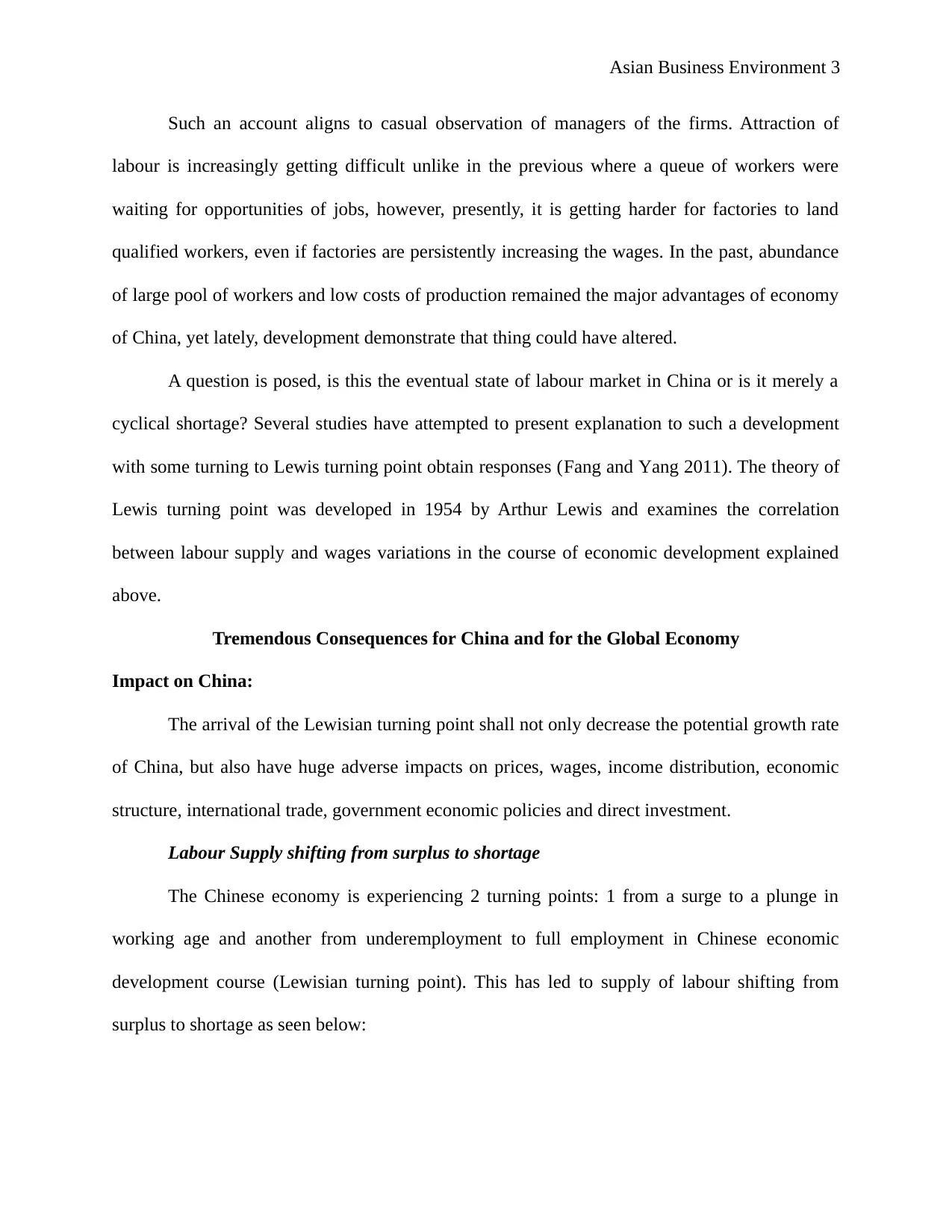
Asian Business Environment 3
Such an account aligns to casual observation of managers of the firms. Attraction of
labour is increasingly getting difficult unlike in the previous where a queue of workers were
waiting for opportunities of jobs, however, presently, it is getting harder for factories to land
qualified workers, even if factories are persistently increasing the wages. In the past, abundance
of large pool of workers and low costs of production remained the major advantages of economy
of China, yet lately, development demonstrate that thing could have altered.
A question is posed, is this the eventual state of labour market in China or is it merely a
cyclical shortage? Several studies have attempted to present explanation to such a development
with some turning to Lewis turning point obtain responses (Fang and Yang 2011). The theory of
Lewis turning point was developed in 1954 by Arthur Lewis and examines the correlation
between labour supply and wages variations in the course of economic development explained
above.
Tremendous Consequences for China and for the Global Economy
Impact on China:
The arrival of the Lewisian turning point shall not only decrease the potential growth rate
of China, but also have huge adverse impacts on prices, wages, income distribution, economic
structure, international trade, government economic policies and direct investment.
Labour Supply shifting from surplus to shortage
The Chinese economy is experiencing 2 turning points: 1 from a surge to a plunge in
working age and another from underemployment to full employment in Chinese economic
development course (Lewisian turning point). This has led to supply of labour shifting from
surplus to shortage as seen below:
Such an account aligns to casual observation of managers of the firms. Attraction of
labour is increasingly getting difficult unlike in the previous where a queue of workers were
waiting for opportunities of jobs, however, presently, it is getting harder for factories to land
qualified workers, even if factories are persistently increasing the wages. In the past, abundance
of large pool of workers and low costs of production remained the major advantages of economy
of China, yet lately, development demonstrate that thing could have altered.
A question is posed, is this the eventual state of labour market in China or is it merely a
cyclical shortage? Several studies have attempted to present explanation to such a development
with some turning to Lewis turning point obtain responses (Fang and Yang 2011). The theory of
Lewis turning point was developed in 1954 by Arthur Lewis and examines the correlation
between labour supply and wages variations in the course of economic development explained
above.
Tremendous Consequences for China and for the Global Economy
Impact on China:
The arrival of the Lewisian turning point shall not only decrease the potential growth rate
of China, but also have huge adverse impacts on prices, wages, income distribution, economic
structure, international trade, government economic policies and direct investment.
Labour Supply shifting from surplus to shortage
The Chinese economy is experiencing 2 turning points: 1 from a surge to a plunge in
working age and another from underemployment to full employment in Chinese economic
development course (Lewisian turning point). This has led to supply of labour shifting from
surplus to shortage as seen below:
⊘ This is a preview!⊘
Do you want full access?
Subscribe today to unlock all pages.

Trusted by 1+ million students worldwide
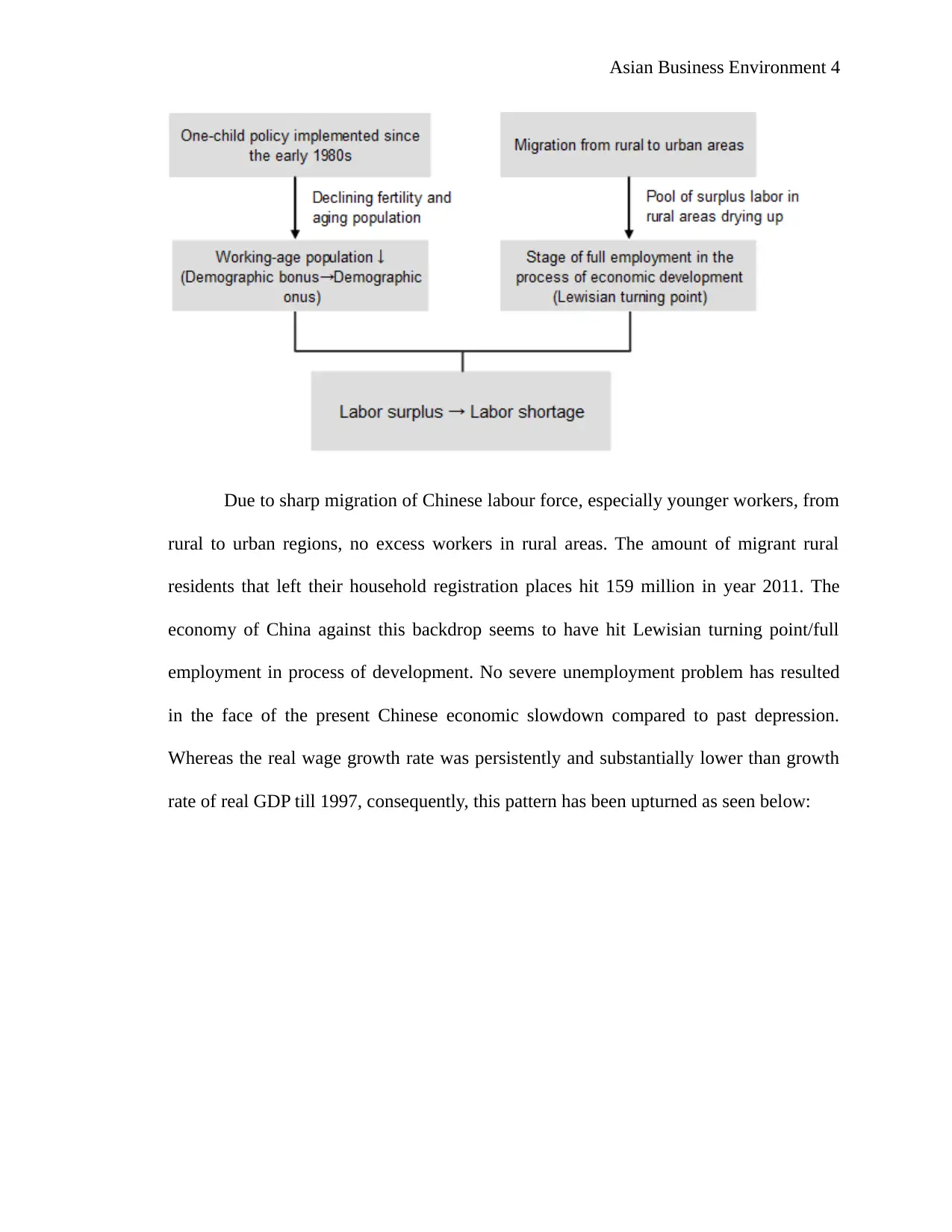
Asian Business Environment 4
Due to sharp migration of Chinese labour force, especially younger workers, from
rural to urban regions, no excess workers in rural areas. The amount of migrant rural
residents that left their household registration places hit 159 million in year 2011. The
economy of China against this backdrop seems to have hit Lewisian turning point/full
employment in process of development. No severe unemployment problem has resulted
in the face of the present Chinese economic slowdown compared to past depression.
Whereas the real wage growth rate was persistently and substantially lower than growth
rate of real GDP till 1997, consequently, this pattern has been upturned as seen below:
Due to sharp migration of Chinese labour force, especially younger workers, from
rural to urban regions, no excess workers in rural areas. The amount of migrant rural
residents that left their household registration places hit 159 million in year 2011. The
economy of China against this backdrop seems to have hit Lewisian turning point/full
employment in process of development. No severe unemployment problem has resulted
in the face of the present Chinese economic slowdown compared to past depression.
Whereas the real wage growth rate was persistently and substantially lower than growth
rate of real GDP till 1997, consequently, this pattern has been upturned as seen below:
Paraphrase This Document
Need a fresh take? Get an instant paraphrase of this document with our AI Paraphraser
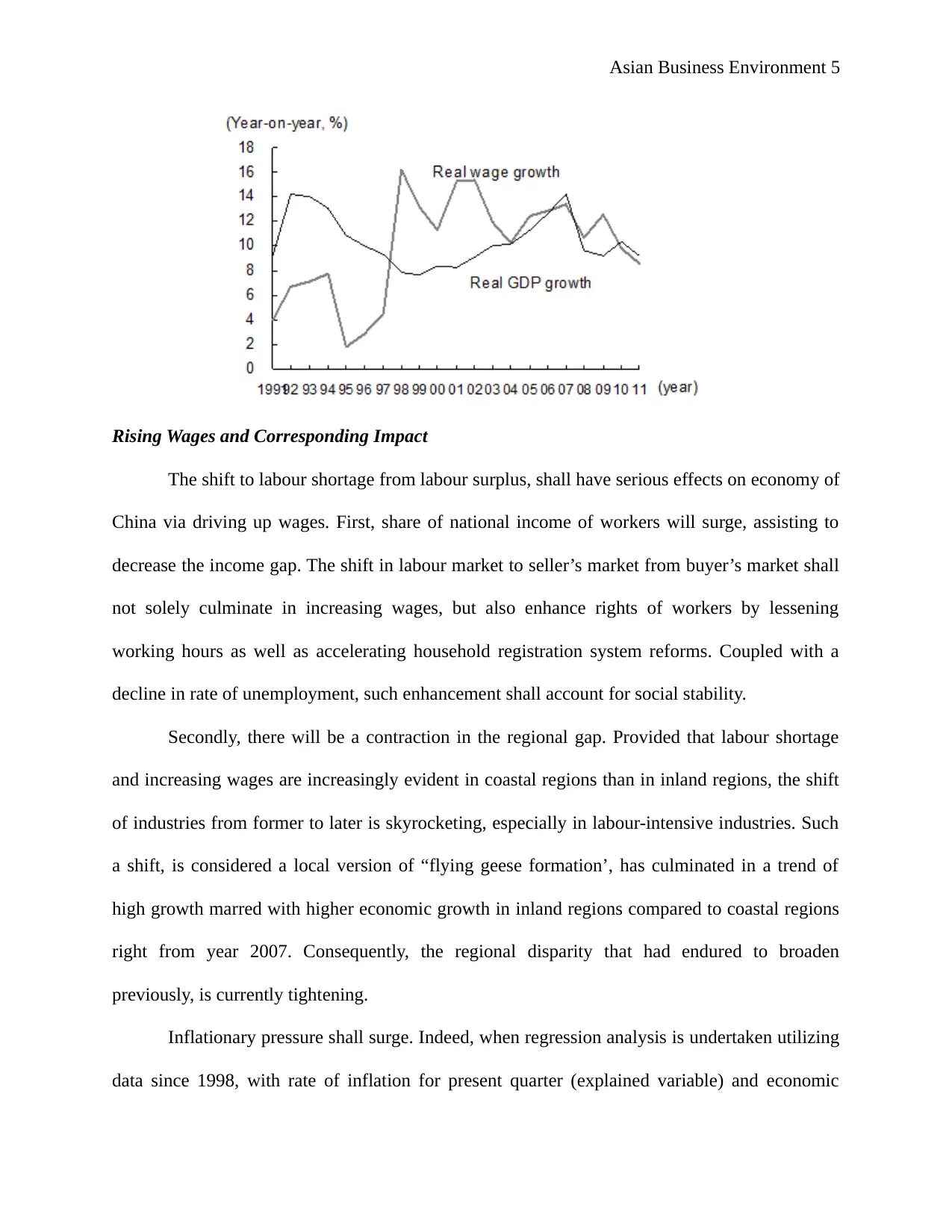
Asian Business Environment 5
Rising Wages and Corresponding Impact
The shift to labour shortage from labour surplus, shall have serious effects on economy of
China via driving up wages. First, share of national income of workers will surge, assisting to
decrease the income gap. The shift in labour market to seller’s market from buyer’s market shall
not solely culminate in increasing wages, but also enhance rights of workers by lessening
working hours as well as accelerating household registration system reforms. Coupled with a
decline in rate of unemployment, such enhancement shall account for social stability.
Secondly, there will be a contraction in the regional gap. Provided that labour shortage
and increasing wages are increasingly evident in coastal regions than in inland regions, the shift
of industries from former to later is skyrocketing, especially in labour-intensive industries. Such
a shift, is considered a local version of “flying geese formation’, has culminated in a trend of
high growth marred with higher economic growth in inland regions compared to coastal regions
right from year 2007. Consequently, the regional disparity that had endured to broaden
previously, is currently tightening.
Inflationary pressure shall surge. Indeed, when regression analysis is undertaken utilizing
data since 1998, with rate of inflation for present quarter (explained variable) and economic
Rising Wages and Corresponding Impact
The shift to labour shortage from labour surplus, shall have serious effects on economy of
China via driving up wages. First, share of national income of workers will surge, assisting to
decrease the income gap. The shift in labour market to seller’s market from buyer’s market shall
not solely culminate in increasing wages, but also enhance rights of workers by lessening
working hours as well as accelerating household registration system reforms. Coupled with a
decline in rate of unemployment, such enhancement shall account for social stability.
Secondly, there will be a contraction in the regional gap. Provided that labour shortage
and increasing wages are increasingly evident in coastal regions than in inland regions, the shift
of industries from former to later is skyrocketing, especially in labour-intensive industries. Such
a shift, is considered a local version of “flying geese formation’, has culminated in a trend of
high growth marred with higher economic growth in inland regions compared to coastal regions
right from year 2007. Consequently, the regional disparity that had endured to broaden
previously, is currently tightening.
Inflationary pressure shall surge. Indeed, when regression analysis is undertaken utilizing
data since 1998, with rate of inflation for present quarter (explained variable) and economic
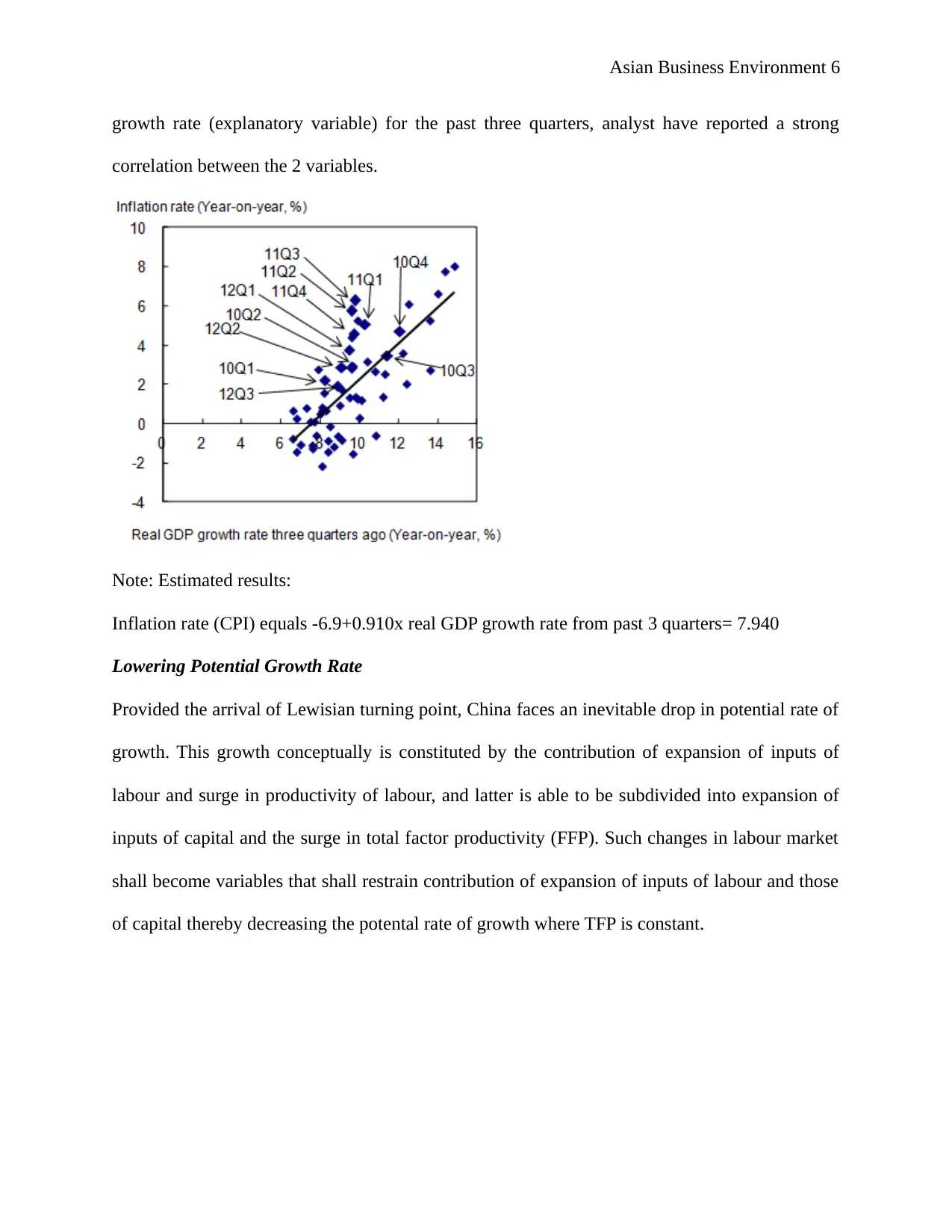
Asian Business Environment 6
growth rate (explanatory variable) for the past three quarters, analyst have reported a strong
correlation between the 2 variables.
Note: Estimated results:
Inflation rate (CPI) equals -6.9+0.910x real GDP growth rate from past 3 quarters= 7.940
Lowering Potential Growth Rate
Provided the arrival of Lewisian turning point, China faces an inevitable drop in potential rate of
growth. This growth conceptually is constituted by the contribution of expansion of inputs of
labour and surge in productivity of labour, and latter is able to be subdivided into expansion of
inputs of capital and the surge in total factor productivity (FFP). Such changes in labour market
shall become variables that shall restrain contribution of expansion of inputs of labour and those
of capital thereby decreasing the potental rate of growth where TFP is constant.
growth rate (explanatory variable) for the past three quarters, analyst have reported a strong
correlation between the 2 variables.
Note: Estimated results:
Inflation rate (CPI) equals -6.9+0.910x real GDP growth rate from past 3 quarters= 7.940
Lowering Potential Growth Rate
Provided the arrival of Lewisian turning point, China faces an inevitable drop in potential rate of
growth. This growth conceptually is constituted by the contribution of expansion of inputs of
labour and surge in productivity of labour, and latter is able to be subdivided into expansion of
inputs of capital and the surge in total factor productivity (FFP). Such changes in labour market
shall become variables that shall restrain contribution of expansion of inputs of labour and those
of capital thereby decreasing the potental rate of growth where TFP is constant.
⊘ This is a preview!⊘
Do you want full access?
Subscribe today to unlock all pages.

Trusted by 1+ million students worldwide
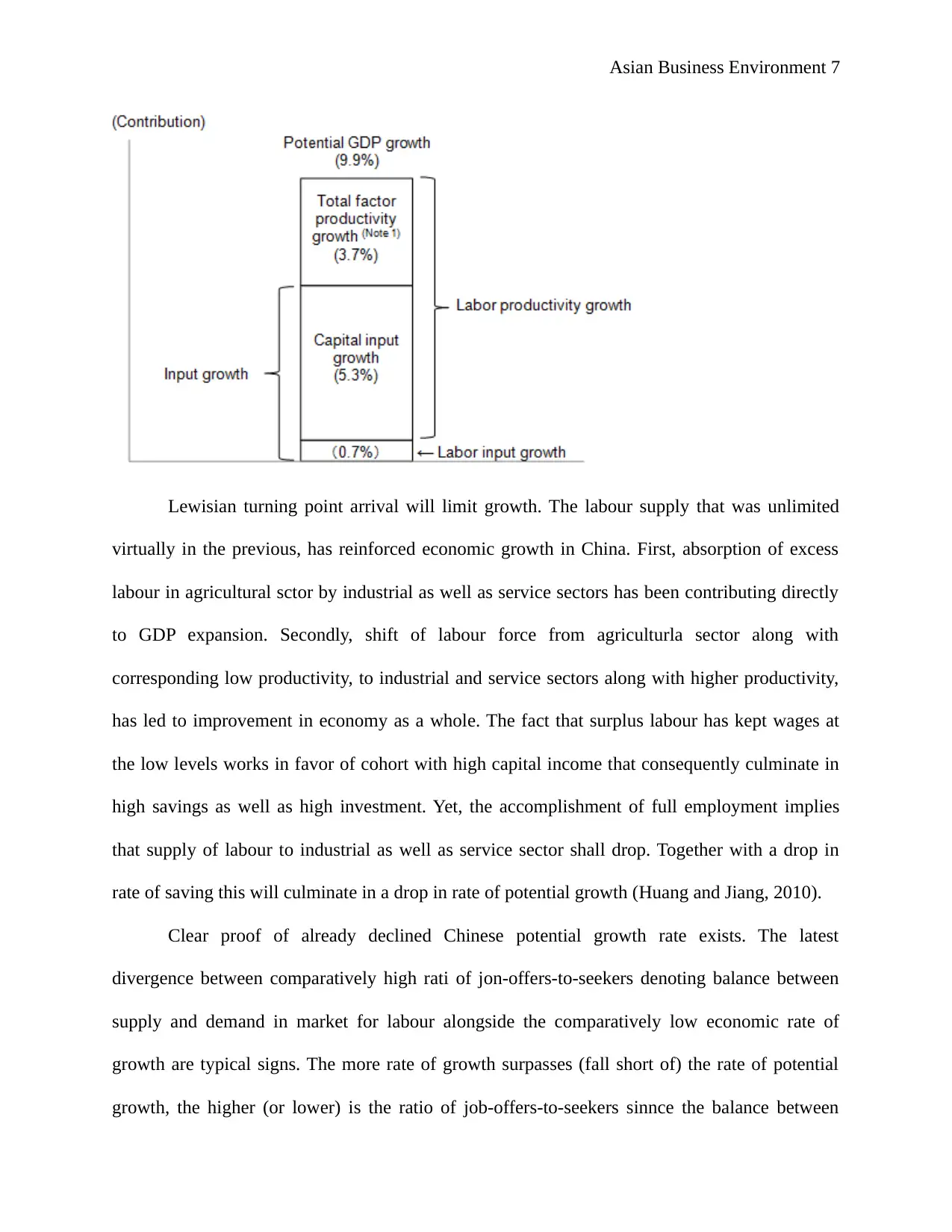
Asian Business Environment 7
Lewisian turning point arrival will limit growth. The labour supply that was unlimited
virtually in the previous, has reinforced economic growth in China. First, absorption of excess
labour in agricultural sctor by industrial as well as service sectors has been contributing directly
to GDP expansion. Secondly, shift of labour force from agriculturla sector along with
corresponding low productivity, to industrial and service sectors along with higher productivity,
has led to improvement in economy as a whole. The fact that surplus labour has kept wages at
the low levels works in favor of cohort with high capital income that consequently culminate in
high savings as well as high investment. Yet, the accomplishment of full employment implies
that supply of labour to industrial as well as service sector shall drop. Together with a drop in
rate of saving this will culminate in a drop in rate of potential growth (Huang and Jiang, 2010).
Clear proof of already declined Chinese potential growth rate exists. The latest
divergence between comparatively high rati of jon-offers-to-seekers denoting balance between
supply and demand in market for labour alongside the comparatively low economic rate of
growth are typical signs. The more rate of growth surpasses (fall short of) the rate of potential
growth, the higher (or lower) is the ratio of job-offers-to-seekers sinnce the balance between
Lewisian turning point arrival will limit growth. The labour supply that was unlimited
virtually in the previous, has reinforced economic growth in China. First, absorption of excess
labour in agricultural sctor by industrial as well as service sectors has been contributing directly
to GDP expansion. Secondly, shift of labour force from agriculturla sector along with
corresponding low productivity, to industrial and service sectors along with higher productivity,
has led to improvement in economy as a whole. The fact that surplus labour has kept wages at
the low levels works in favor of cohort with high capital income that consequently culminate in
high savings as well as high investment. Yet, the accomplishment of full employment implies
that supply of labour to industrial as well as service sector shall drop. Together with a drop in
rate of saving this will culminate in a drop in rate of potential growth (Huang and Jiang, 2010).
Clear proof of already declined Chinese potential growth rate exists. The latest
divergence between comparatively high rati of jon-offers-to-seekers denoting balance between
supply and demand in market for labour alongside the comparatively low economic rate of
growth are typical signs. The more rate of growth surpasses (fall short of) the rate of potential
growth, the higher (or lower) is the ratio of job-offers-to-seekers sinnce the balance between
Paraphrase This Document
Need a fresh take? Get an instant paraphrase of this document with our AI Paraphraser
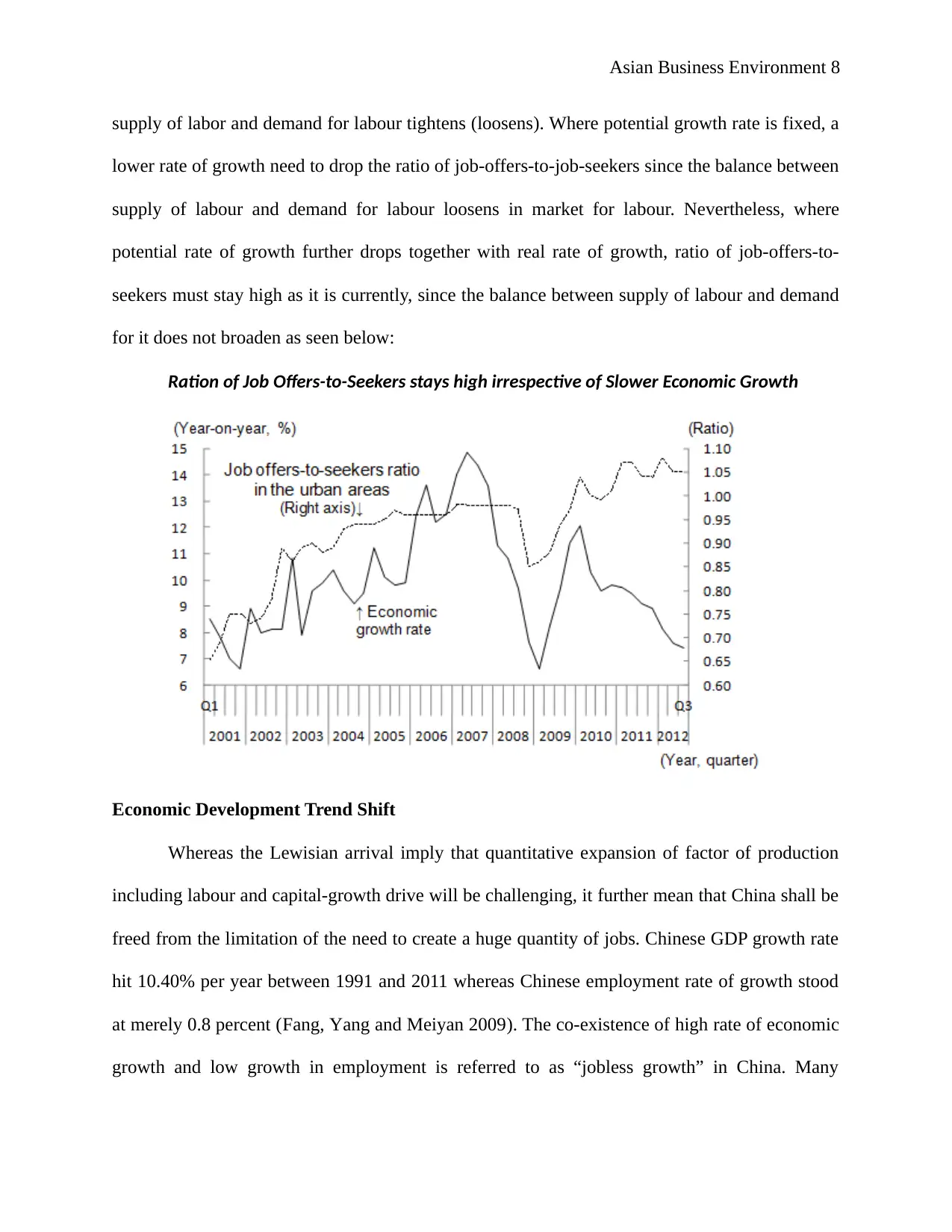
Asian Business Environment 8
supply of labor and demand for labour tightens (loosens). Where potential growth rate is fixed, a
lower rate of growth need to drop the ratio of job-offers-to-job-seekers since the balance between
supply of labour and demand for labour loosens in market for labour. Nevertheless, where
potential rate of growth further drops together with real rate of growth, ratio of job-offers-to-
seekers must stay high as it is currently, since the balance between supply of labour and demand
for it does not broaden as seen below:
Ration of Job Offers-to-Seekers stays high irrespective of Slower Economic Growth
Economic Development Trend Shift
Whereas the Lewisian arrival imply that quantitative expansion of factor of production
including labour and capital-growth drive will be challenging, it further mean that China shall be
freed from the limitation of the need to create a huge quantity of jobs. Chinese GDP growth rate
hit 10.40% per year between 1991 and 2011 whereas Chinese employment rate of growth stood
at merely 0.8 percent (Fang, Yang and Meiyan 2009). The co-existence of high rate of economic
growth and low growth in employment is referred to as “jobless growth” in China. Many
supply of labor and demand for labour tightens (loosens). Where potential growth rate is fixed, a
lower rate of growth need to drop the ratio of job-offers-to-job-seekers since the balance between
supply of labour and demand for labour loosens in market for labour. Nevertheless, where
potential rate of growth further drops together with real rate of growth, ratio of job-offers-to-
seekers must stay high as it is currently, since the balance between supply of labour and demand
for it does not broaden as seen below:
Ration of Job Offers-to-Seekers stays high irrespective of Slower Economic Growth
Economic Development Trend Shift
Whereas the Lewisian arrival imply that quantitative expansion of factor of production
including labour and capital-growth drive will be challenging, it further mean that China shall be
freed from the limitation of the need to create a huge quantity of jobs. Chinese GDP growth rate
hit 10.40% per year between 1991 and 2011 whereas Chinese employment rate of growth stood
at merely 0.8 percent (Fang, Yang and Meiyan 2009). The co-existence of high rate of economic
growth and low growth in employment is referred to as “jobless growth” in China. Many
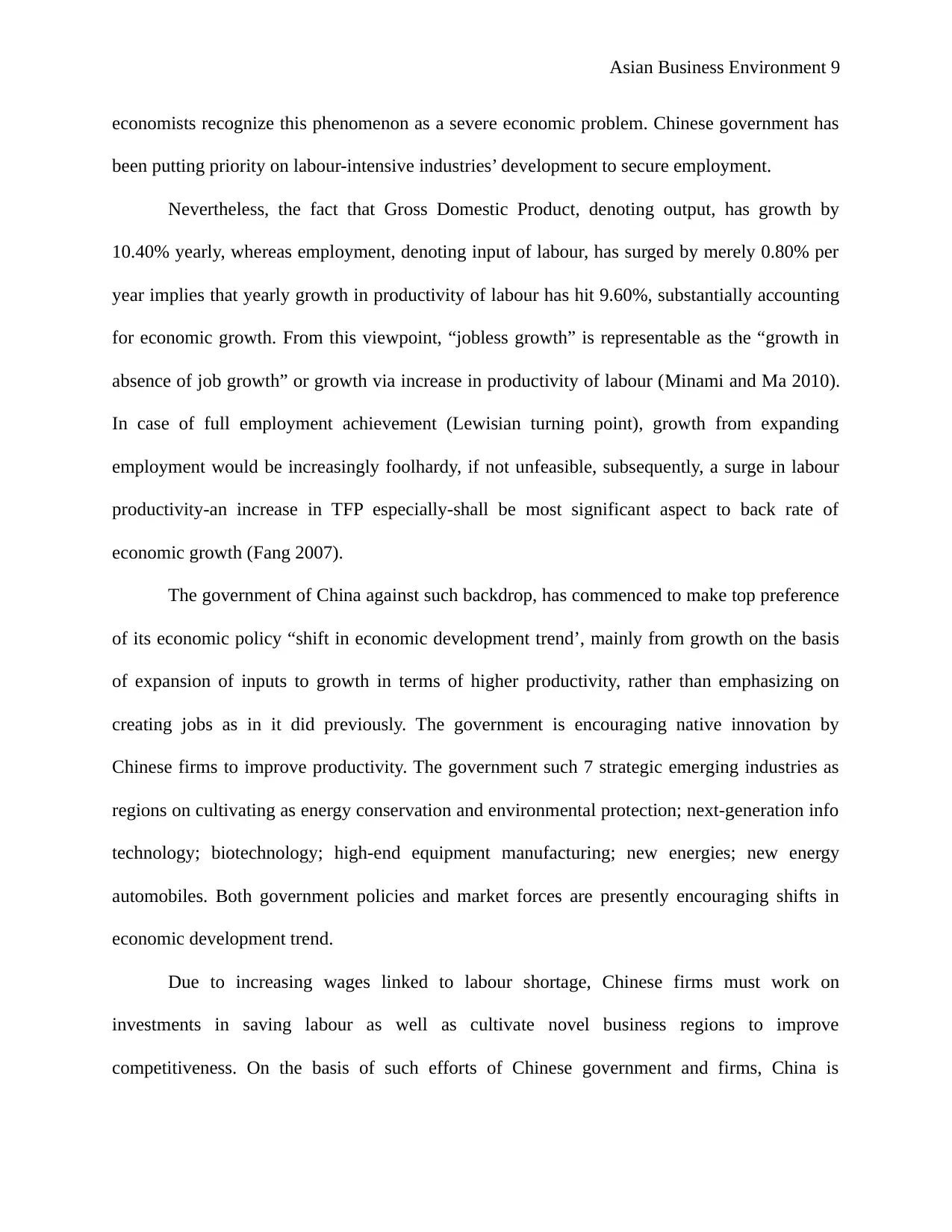
Asian Business Environment 9
economists recognize this phenomenon as a severe economic problem. Chinese government has
been putting priority on labour-intensive industries’ development to secure employment.
Nevertheless, the fact that Gross Domestic Product, denoting output, has growth by
10.40% yearly, whereas employment, denoting input of labour, has surged by merely 0.80% per
year implies that yearly growth in productivity of labour has hit 9.60%, substantially accounting
for economic growth. From this viewpoint, “jobless growth” is representable as the “growth in
absence of job growth” or growth via increase in productivity of labour (Minami and Ma 2010).
In case of full employment achievement (Lewisian turning point), growth from expanding
employment would be increasingly foolhardy, if not unfeasible, subsequently, a surge in labour
productivity-an increase in TFP especially-shall be most significant aspect to back rate of
economic growth (Fang 2007).
The government of China against such backdrop, has commenced to make top preference
of its economic policy “shift in economic development trend’, mainly from growth on the basis
of expansion of inputs to growth in terms of higher productivity, rather than emphasizing on
creating jobs as in it did previously. The government is encouraging native innovation by
Chinese firms to improve productivity. The government such 7 strategic emerging industries as
regions on cultivating as energy conservation and environmental protection; next-generation info
technology; biotechnology; high-end equipment manufacturing; new energies; new energy
automobiles. Both government policies and market forces are presently encouraging shifts in
economic development trend.
Due to increasing wages linked to labour shortage, Chinese firms must work on
investments in saving labour as well as cultivate novel business regions to improve
competitiveness. On the basis of such efforts of Chinese government and firms, China is
economists recognize this phenomenon as a severe economic problem. Chinese government has
been putting priority on labour-intensive industries’ development to secure employment.
Nevertheless, the fact that Gross Domestic Product, denoting output, has growth by
10.40% yearly, whereas employment, denoting input of labour, has surged by merely 0.80% per
year implies that yearly growth in productivity of labour has hit 9.60%, substantially accounting
for economic growth. From this viewpoint, “jobless growth” is representable as the “growth in
absence of job growth” or growth via increase in productivity of labour (Minami and Ma 2010).
In case of full employment achievement (Lewisian turning point), growth from expanding
employment would be increasingly foolhardy, if not unfeasible, subsequently, a surge in labour
productivity-an increase in TFP especially-shall be most significant aspect to back rate of
economic growth (Fang 2007).
The government of China against such backdrop, has commenced to make top preference
of its economic policy “shift in economic development trend’, mainly from growth on the basis
of expansion of inputs to growth in terms of higher productivity, rather than emphasizing on
creating jobs as in it did previously. The government is encouraging native innovation by
Chinese firms to improve productivity. The government such 7 strategic emerging industries as
regions on cultivating as energy conservation and environmental protection; next-generation info
technology; biotechnology; high-end equipment manufacturing; new energies; new energy
automobiles. Both government policies and market forces are presently encouraging shifts in
economic development trend.
Due to increasing wages linked to labour shortage, Chinese firms must work on
investments in saving labour as well as cultivate novel business regions to improve
competitiveness. On the basis of such efforts of Chinese government and firms, China is
⊘ This is a preview!⊘
Do you want full access?
Subscribe today to unlock all pages.

Trusted by 1+ million students worldwide
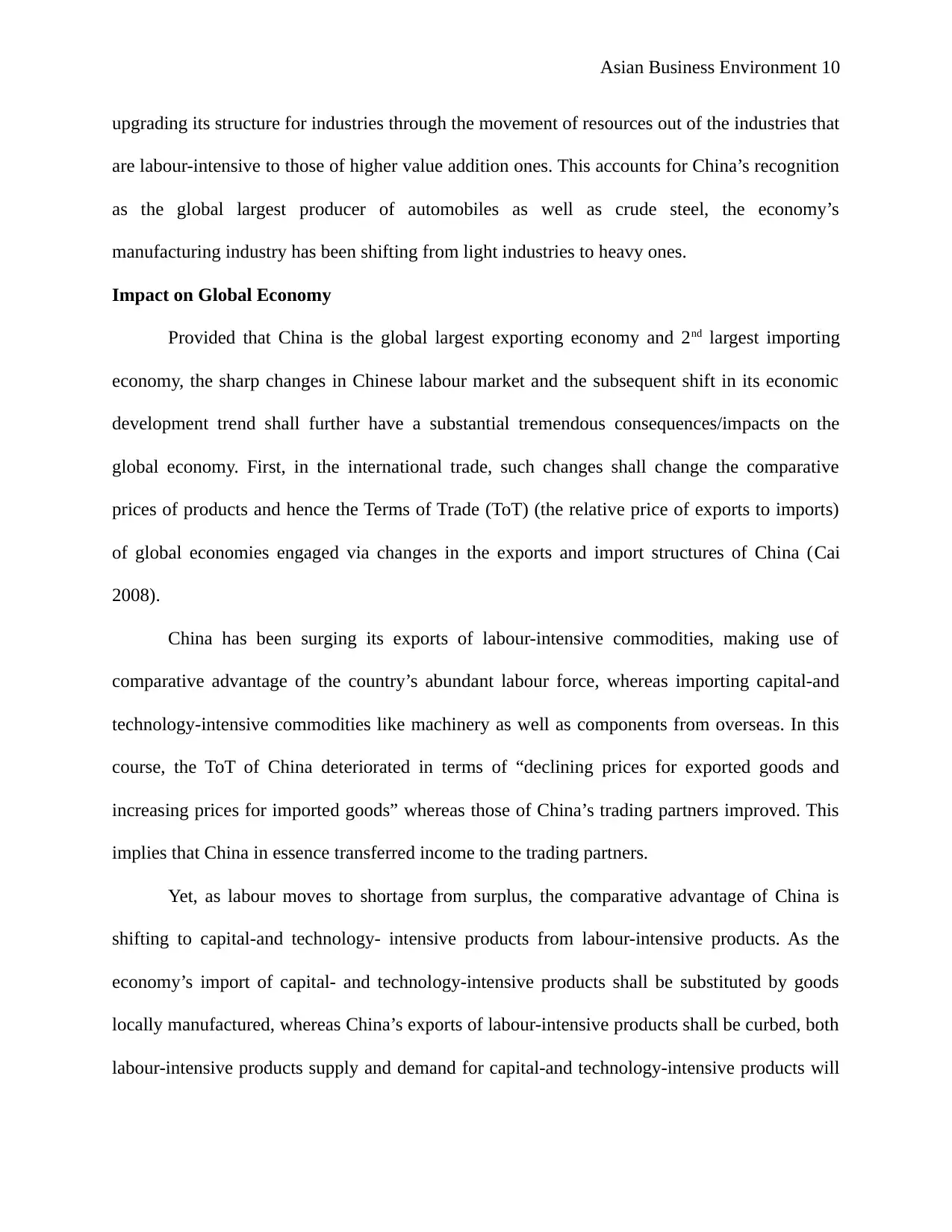
Asian Business Environment 10
upgrading its structure for industries through the movement of resources out of the industries that
are labour-intensive to those of higher value addition ones. This accounts for China’s recognition
as the global largest producer of automobiles as well as crude steel, the economy’s
manufacturing industry has been shifting from light industries to heavy ones.
Impact on Global Economy
Provided that China is the global largest exporting economy and 2nd largest importing
economy, the sharp changes in Chinese labour market and the subsequent shift in its economic
development trend shall further have a substantial tremendous consequences/impacts on the
global economy. First, in the international trade, such changes shall change the comparative
prices of products and hence the Terms of Trade (ToT) (the relative price of exports to imports)
of global economies engaged via changes in the exports and import structures of China (Cai
2008).
China has been surging its exports of labour-intensive commodities, making use of
comparative advantage of the country’s abundant labour force, whereas importing capital-and
technology-intensive commodities like machinery as well as components from overseas. In this
course, the ToT of China deteriorated in terms of “declining prices for exported goods and
increasing prices for imported goods” whereas those of China’s trading partners improved. This
implies that China in essence transferred income to the trading partners.
Yet, as labour moves to shortage from surplus, the comparative advantage of China is
shifting to capital-and technology- intensive products from labour-intensive products. As the
economy’s import of capital- and technology-intensive products shall be substituted by goods
locally manufactured, whereas China’s exports of labour-intensive products shall be curbed, both
labour-intensive products supply and demand for capital-and technology-intensive products will
upgrading its structure for industries through the movement of resources out of the industries that
are labour-intensive to those of higher value addition ones. This accounts for China’s recognition
as the global largest producer of automobiles as well as crude steel, the economy’s
manufacturing industry has been shifting from light industries to heavy ones.
Impact on Global Economy
Provided that China is the global largest exporting economy and 2nd largest importing
economy, the sharp changes in Chinese labour market and the subsequent shift in its economic
development trend shall further have a substantial tremendous consequences/impacts on the
global economy. First, in the international trade, such changes shall change the comparative
prices of products and hence the Terms of Trade (ToT) (the relative price of exports to imports)
of global economies engaged via changes in the exports and import structures of China (Cai
2008).
China has been surging its exports of labour-intensive commodities, making use of
comparative advantage of the country’s abundant labour force, whereas importing capital-and
technology-intensive commodities like machinery as well as components from overseas. In this
course, the ToT of China deteriorated in terms of “declining prices for exported goods and
increasing prices for imported goods” whereas those of China’s trading partners improved. This
implies that China in essence transferred income to the trading partners.
Yet, as labour moves to shortage from surplus, the comparative advantage of China is
shifting to capital-and technology- intensive products from labour-intensive products. As the
economy’s import of capital- and technology-intensive products shall be substituted by goods
locally manufactured, whereas China’s exports of labour-intensive products shall be curbed, both
labour-intensive products supply and demand for capital-and technology-intensive products will
Paraphrase This Document
Need a fresh take? Get an instant paraphrase of this document with our AI Paraphraser
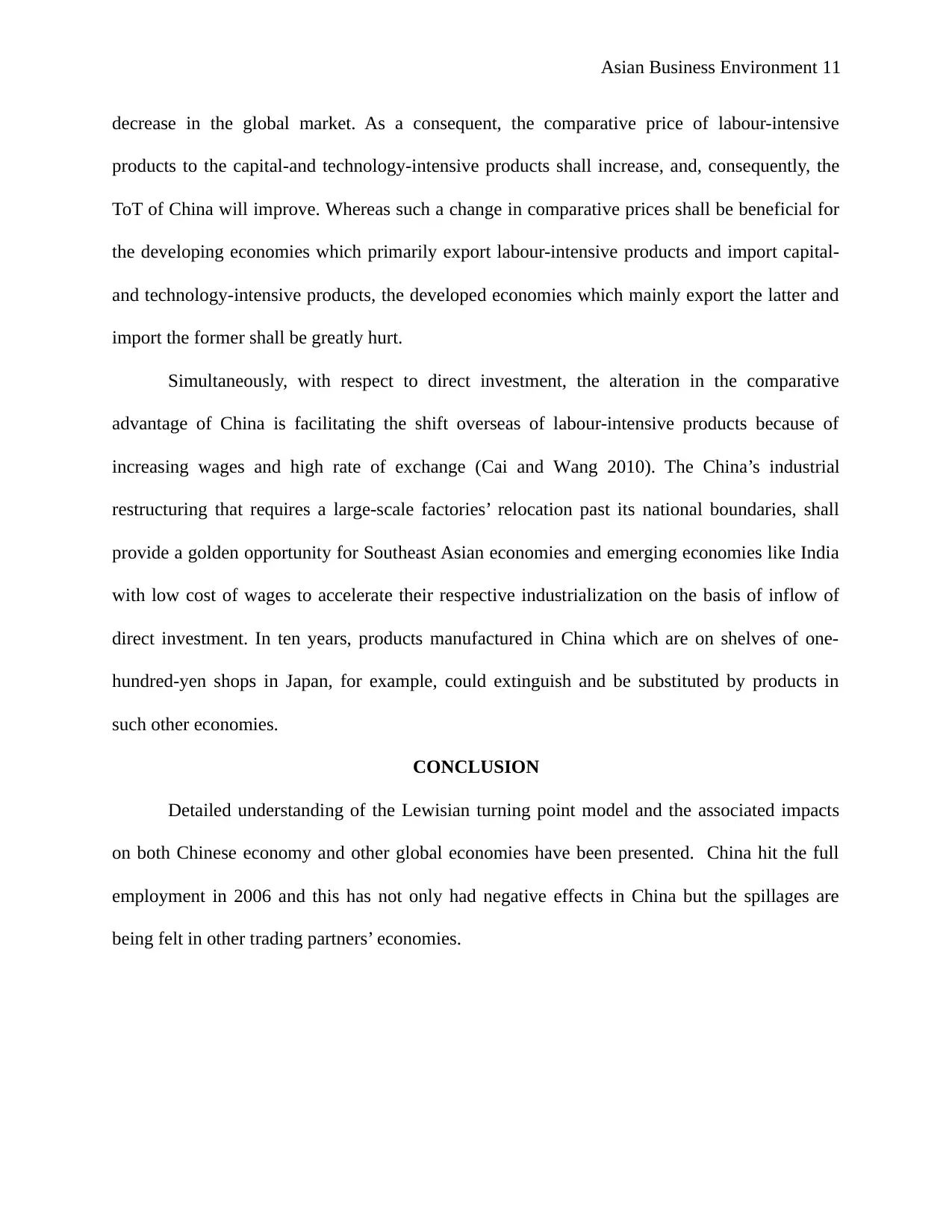
Asian Business Environment 11
decrease in the global market. As a consequent, the comparative price of labour-intensive
products to the capital-and technology-intensive products shall increase, and, consequently, the
ToT of China will improve. Whereas such a change in comparative prices shall be beneficial for
the developing economies which primarily export labour-intensive products and import capital-
and technology-intensive products, the developed economies which mainly export the latter and
import the former shall be greatly hurt.
Simultaneously, with respect to direct investment, the alteration in the comparative
advantage of China is facilitating the shift overseas of labour-intensive products because of
increasing wages and high rate of exchange (Cai and Wang 2010). The China’s industrial
restructuring that requires a large-scale factories’ relocation past its national boundaries, shall
provide a golden opportunity for Southeast Asian economies and emerging economies like India
with low cost of wages to accelerate their respective industrialization on the basis of inflow of
direct investment. In ten years, products manufactured in China which are on shelves of one-
hundred-yen shops in Japan, for example, could extinguish and be substituted by products in
such other economies.
CONCLUSION
Detailed understanding of the Lewisian turning point model and the associated impacts
on both Chinese economy and other global economies have been presented. China hit the full
employment in 2006 and this has not only had negative effects in China but the spillages are
being felt in other trading partners’ economies.
decrease in the global market. As a consequent, the comparative price of labour-intensive
products to the capital-and technology-intensive products shall increase, and, consequently, the
ToT of China will improve. Whereas such a change in comparative prices shall be beneficial for
the developing economies which primarily export labour-intensive products and import capital-
and technology-intensive products, the developed economies which mainly export the latter and
import the former shall be greatly hurt.
Simultaneously, with respect to direct investment, the alteration in the comparative
advantage of China is facilitating the shift overseas of labour-intensive products because of
increasing wages and high rate of exchange (Cai and Wang 2010). The China’s industrial
restructuring that requires a large-scale factories’ relocation past its national boundaries, shall
provide a golden opportunity for Southeast Asian economies and emerging economies like India
with low cost of wages to accelerate their respective industrialization on the basis of inflow of
direct investment. In ten years, products manufactured in China which are on shelves of one-
hundred-yen shops in Japan, for example, could extinguish and be substituted by products in
such other economies.
CONCLUSION
Detailed understanding of the Lewisian turning point model and the associated impacts
on both Chinese economy and other global economies have been presented. China hit the full
employment in 2006 and this has not only had negative effects in China but the spillages are
being felt in other trading partners’ economies.
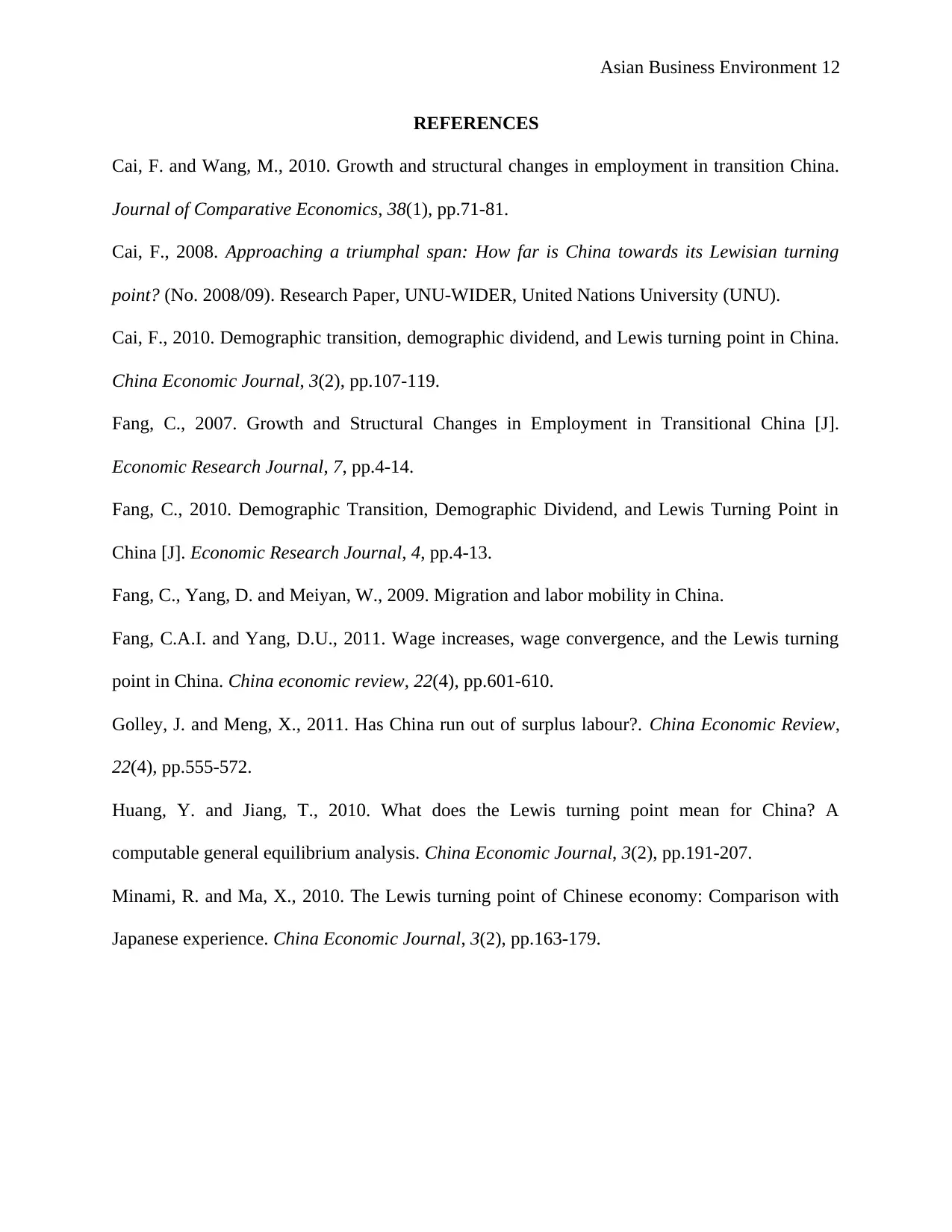
Asian Business Environment 12
REFERENCES
Cai, F. and Wang, M., 2010. Growth and structural changes in employment in transition China.
Journal of Comparative Economics, 38(1), pp.71-81.
Cai, F., 2008. Approaching a triumphal span: How far is China towards its Lewisian turning
point? (No. 2008/09). Research Paper, UNU-WIDER, United Nations University (UNU).
Cai, F., 2010. Demographic transition, demographic dividend, and Lewis turning point in China.
China Economic Journal, 3(2), pp.107-119.
Fang, C., 2007. Growth and Structural Changes in Employment in Transitional China [J].
Economic Research Journal, 7, pp.4-14.
Fang, C., 2010. Demographic Transition, Demographic Dividend, and Lewis Turning Point in
China [J]. Economic Research Journal, 4, pp.4-13.
Fang, C., Yang, D. and Meiyan, W., 2009. Migration and labor mobility in China.
Fang, C.A.I. and Yang, D.U., 2011. Wage increases, wage convergence, and the Lewis turning
point in China. China economic review, 22(4), pp.601-610.
Golley, J. and Meng, X., 2011. Has China run out of surplus labour?. China Economic Review,
22(4), pp.555-572.
Huang, Y. and Jiang, T., 2010. What does the Lewis turning point mean for China? A
computable general equilibrium analysis. China Economic Journal, 3(2), pp.191-207.
Minami, R. and Ma, X., 2010. The Lewis turning point of Chinese economy: Comparison with
Japanese experience. China Economic Journal, 3(2), pp.163-179.
REFERENCES
Cai, F. and Wang, M., 2010. Growth and structural changes in employment in transition China.
Journal of Comparative Economics, 38(1), pp.71-81.
Cai, F., 2008. Approaching a triumphal span: How far is China towards its Lewisian turning
point? (No. 2008/09). Research Paper, UNU-WIDER, United Nations University (UNU).
Cai, F., 2010. Demographic transition, demographic dividend, and Lewis turning point in China.
China Economic Journal, 3(2), pp.107-119.
Fang, C., 2007. Growth and Structural Changes in Employment in Transitional China [J].
Economic Research Journal, 7, pp.4-14.
Fang, C., 2010. Demographic Transition, Demographic Dividend, and Lewis Turning Point in
China [J]. Economic Research Journal, 4, pp.4-13.
Fang, C., Yang, D. and Meiyan, W., 2009. Migration and labor mobility in China.
Fang, C.A.I. and Yang, D.U., 2011. Wage increases, wage convergence, and the Lewis turning
point in China. China economic review, 22(4), pp.601-610.
Golley, J. and Meng, X., 2011. Has China run out of surplus labour?. China Economic Review,
22(4), pp.555-572.
Huang, Y. and Jiang, T., 2010. What does the Lewis turning point mean for China? A
computable general equilibrium analysis. China Economic Journal, 3(2), pp.191-207.
Minami, R. and Ma, X., 2010. The Lewis turning point of Chinese economy: Comparison with
Japanese experience. China Economic Journal, 3(2), pp.163-179.
⊘ This is a preview!⊘
Do you want full access?
Subscribe today to unlock all pages.

Trusted by 1+ million students worldwide
1 out of 12
Your All-in-One AI-Powered Toolkit for Academic Success.
+13062052269
info@desklib.com
Available 24*7 on WhatsApp / Email
![[object Object]](/_next/static/media/star-bottom.7253800d.svg)
Unlock your academic potential
Copyright © 2020–2025 A2Z Services. All Rights Reserved. Developed and managed by ZUCOL.